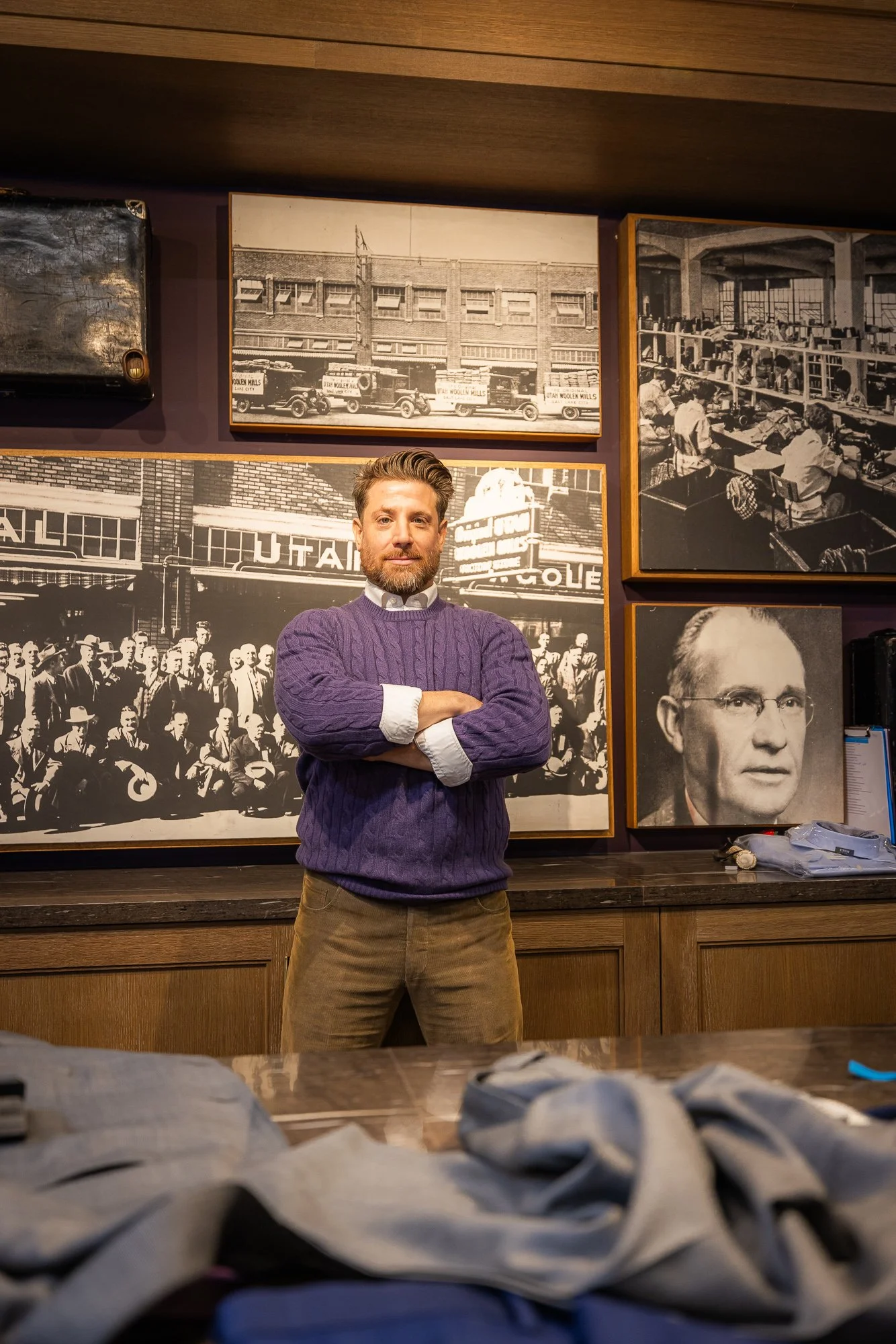There's a moment most people recognize but few examine: the shift that happens when you change from loungewear into something more intentional. The posture straightens. The pace of thought changes. Even internal dialogue sounds different—less scattered, more directed. This isn't superstition or placebo, though it might feel like both. It's fashion psychology at work, the documented phenomenon where what we wear influences how we think, decide, and create. Understanding this relationship—between fabric and focus, between structure and mental state—offers something more valuable than style advice. It offers cognitive control.
The field of clothing psychology has spent decades proving what tailors and theater directors always knew intuitively: garments aren't neutral. They carry associations, trigger responses, and create feedback loops between body and mind. When researchers talk about "enclothed cognition," they're describing how wearing certain items activates the psychological qualities we associate with them. Put on a white coat, and you'll perform better on attention-demanding tasks—but only if you believe it's a doctor's coat rather than a painter's smock. The clothing doesn't change; the meaning does. And that meaning, once activated, shapes everything from men's confidence to creative output.
The Structure-Creativity Paradox
Common wisdom suggests that creativity requires freedom, that structure inhibits innovation. Tech culture embraced this idea enthusiastically, trading suits for hoodies and declaring formal dress the enemy of original thinking. But fashion psychology tells a more complicated story. Structure doesn't suppress creativity—it channels it. And sometimes, constraint is exactly what unfocused thinking needs.
Consider how architects work. When designing a building, they don't start with infinite possibilities—they start with site boundaries, building codes, budget limits, and client requirements. These constraints don't prevent creativity; they give it direction. Clothing works similarly. A well-fitted jacket doesn't restrict movement so much as make you conscious of it, turning casual gestures into deliberate ones. That awareness ripples outward, affecting how you approach problems and make decisions.
Studies on clothing psychology have found that formal dress increases abstract thinking—the kind that connects disparate concepts and recognizes patterns across domains. Casual dress, conversely, correlates with concrete, detail-oriented thinking. Neither is better absolutely; they're tools for different cognitive jobs. When you need to see the forest, formal structure helps. When you need to count the trees, comfort and ease might serve you better. Understanding this means you can dress strategically for the type of thinking your day demands.
The paradox resolves when you realize that creative style isn't about choosing between structure and freedom, it's about knowing which serves your current cognitive needs. The writer who struggles with organization might benefit from writing in a jacket. The engineer who needs breakthrough thinking might work better without one. Your wardrobe becomes a variable you can adjust, like lighting or music, to shift mental state.
Confidence: The Mediating Variable
Nothing in fashion psychology works without confidence, and confidence itself is partly constructed through dress. We're not talking about arrogance or the shallow swagger of expensive labels. We mean the stable self-assurance that comes from feeling appropriately dressed for the situation at hand, from knowing you've made choices that align with your intent.
Men's confidence through clothing operates on multiple levels simultaneously. There's the external validation, or the way people respond when you're well-dressed, which reinforces positive self-perception. There's the internal feedback from your own body—good posture encouraged by structured garments, comfort allowing ease of movement. And there's the symbolic dimension: wearing items associated with competence and authority to trigger those qualities in yourself.
Research consistently shows that people who feel well-dressed perform better in negotiations, speak more authoritatively in presentations, and recover faster from setbacks. The clothing doesn't magically grant these abilities; it removes the cognitive interference of self-consciousness. When you trust that your appearance is handled, mental bandwidth previously devoted to appearance anxiety becomes available for the actual task. This is why the most successful people often develop uniforms—not to eliminate choice, but to eliminate doubt.
The confidence mechanism works differently for different people, which is why prescriptive style advice often fails. One man might feel most capable in a three-piece suit; another might feel most himself in selvedge denim and a work shirt. Creative style recognizes this variation and encourages building a wardrobe that serves your particular psychology rather than following universal rules that serve no one perfectly.
The Morning Ritual: Setting Cognitive Tone
The first clothing decision of the day carries disproportionate weight. It's not just about covering the body or looking appropriate; it's about establishing a cognitive framework for the hours ahead. This is where clothing psychology becomes immediately practical rather than theoretically interesting.
When you dress with intention in the morning, you're essentially priming yourself for a particular mindset. Formal dress signals to your brain that you're entering performance mode—meetings, presentations, situations requiring polish and precision. Business casual suggests professional work but with more flexibility and interpersonal ease. Completely casual dress keeps you in rest-and-recharge mode, good for creative incubation but potentially problematic if you need to produce on deadline.
The ritual matters as much as the result. Taking time to choose, to button, to knot a tie or lace proper shoes—these acts create transition space between sleep and work, between private self and public role. They're not wasted minutes but invested ones, establishing psychological boundaries that make it easier to focus once the day begins. People who work from home often struggle with this, rolling from bed to desk in whatever they slept in, then wondering why focus feels slippery. The absence of clothing ritual removes a crucial cognitive threshold.
Smart professionals treat morning dressing as performance preparation. Actors don't step on stage in street clothes; they transform gradually through costume and makeup, building the character as they dress. Your workday deserves similar respect. Even if no one will see you, the act of dressing appropriately tells your brain the show is starting, that it's time to engage rather than drift.
Creative Work: When to Structure, When to Soften
Different creative phases benefit from different dress codes, something fashion psychology is only beginning to explore systematically. Anecdotal evidence from creatives across fields suggests patterns worth considering, even if research hasn't caught up yet.
During ideation, when you need loose, associative thinking, many people report working best in comfortable, unstructured clothing. Soft fabrics, elastic waists, nothing binding at the neck or wrists. The body's ease seems to encourage mental ease, allowing thoughts to wander productively rather than march in rigid lines. This is when artists wear paint-stained clothes, when writers work in sweats, when designers sketch in whatever they woke up in.
During execution, when ideas must become reality, structure helps. Musicians performing don't dress like musicians practicing. The formality signals that precision matters now, that there's an audience (even if it's just yourself) and the work must be finished rather than explored. A photographer editing might wear something more deliberate than a photographer shooting. The clothing shift marks the phase transition from capture to curation.
During presentation, when creative work meets audience or client, creative style requires calibration. Too formal, and you risk seeming disconnected from the creative process. Too casual, and you risk seeming unprofessional. The sweet spot usually involves intentional dress that maintains individuality—tailored but not corporate, polished but not stuffy. This is where creative professionals develop their signature looks: the architect in black and Japanese denim, the designer in precise minimalism, the writer in vintage tweeds. They're formal enough to be taken seriously, individual enough to signal creative authority.
Texture, Weight, and Cognitive Feedback
Clothing psychology extends beyond what we see to what we feel against our skin. Texture and weight provide constant sensory feedback that influences mood and focus in ways we rarely acknowledge consciously but experience continuously.
Heavy, structured fabrics like thick wool, starched cotton, and substantial denim create a kind of productive constraint. They make you aware of your body's boundaries, which paradoxically can help focus wandering attention. Many people report that they think more clearly in jeans than in sweatpants, despite the latter being more comfortable, because denim's weight and structure provide grounding sensation.
Light, flowing fabrics like silk, lightweight linen, or soft jersey reduce sensory input, which can be freeing or destabilizing depending on your needs. When you want to feel unencumbered, they work beautifully. When you need to feel contained and directed, they might encourage mental drift. Texture matters too: smooth fabrics feel polished and sleek, potentially encouraging similar thinking; textured fabrics feel more grounded and substantial.
Professional contexts often require smooth, crisp textures such as the tightly woven cotton of dress shirts, the smooth finish of worsted wool. These surfaces read as polished and controlled, qualities we associate with competence. Creative contexts allow more texture—chambray, tweed, knits—which feel more human and less corporate. Neither is inherently better, but they signal and potentially encourage different cognitive approaches.
Remote Work: When the Audience Is You
The shift to remote work exposed something interesting: many people dress differently when no one's watching. Some maintained professional standards, discovering that men's confidence and focus depended on it. Others abandoned formality entirely, finding that comfort improved their mood and productivity. Neither group was wrong; they were simply discovering their personal relationship between dress and cognition.
Clothing psychology in remote work suggests that individual variation matters more than universal rules. Some minds need the psychological threshold of proper dress to shift into work mode. Others find that threshold burdensome, preferring to ease into focus gradually. The key is honest self-assessment: does your current approach actually work, or have you simply rationalized what's easiest?
A useful experiment is varying your dress deliberately for a week—fully professional Monday and Tuesday, completely casual Wednesday and Thursday, somewhere between Friday—and tracking not just comfort but actual output and mental clarity. You might discover that what you assumed was your preference is actually habit, and that a different approach serves you better. Or you might confirm that your instincts were correct all along.
Bringing It Home: Practical Application
Understanding fashion psychology doesn't require adopting someone else's system or following prescriptive rules about what works. It requires paying attention to your own responses—noticing when you feel sharp versus scattered, confident versus uncertain, creative versus constrained. Then it requires treating clothing as a tool you can adjust deliberately to support different cognitive states.
Build a wardrobe with range: pieces for when you need structure, pieces for when you need ease, pieces that split the difference. Develop intuition about which situations and tasks benefit from formality and which benefit from comfort. Use morning dressing as transition ritual rather than mindless routine. Experiment with color, texture, and fit to find what makes you feel capable rather than costumed.
The goal isn't looking good for others—though that's a pleasant side effect. The goal is giving yourself every advantage in a world that demands clarity, creativity, and confidence simultaneously. Creative style recognizes that these qualities don't emerge from nowhere. They're supported or undermined by dozens of small choices, including what you decide to wear before your feet hit the floor each morning.
Dress for the person you need to be that day. Your mind is already listening.





